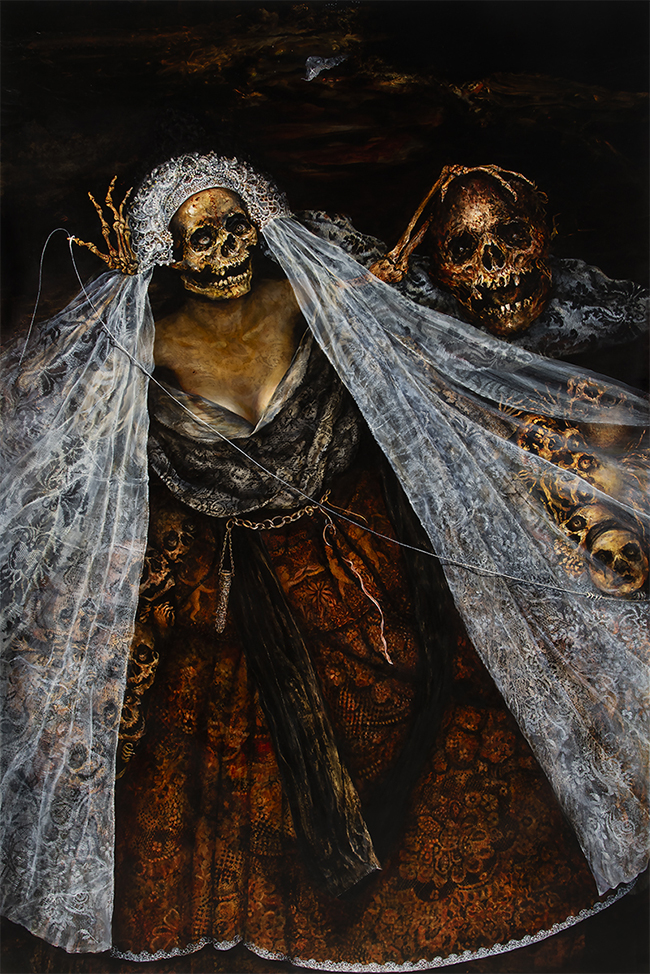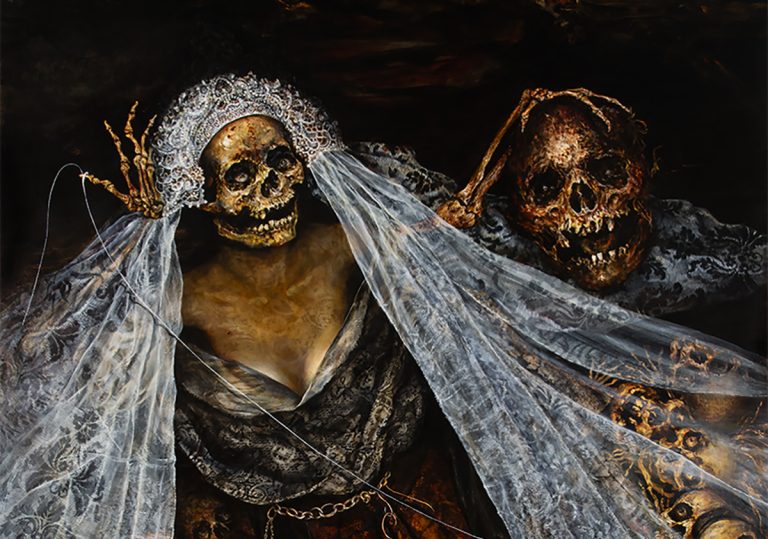Terry Taylor doesn’t paint in whispers. Her work enters the room like a force—unapologetic, raw, and grounded in the human condition. Her paintings aren’t meant to decorate; they’re meant to confront. Taylor is driven by a need to reveal the underlayers of being—what she calls “the naked existence of humans.” She peels back identity, ambition, even dignity, to show the creature beneath. In her view, flesh carries memory, and spirit is heavy with experience.

There’s no romantic gloss in her work. What you see is what remains after illusion has burned away. Taylor’s process is intuitive but anchored in deep observation. Her paintings are built on feeling and reckoning. She doesn’t look away—and she doesn’t let you look away, either.
Bride of Humanity (2024)
Taylor’s Bride of Humanity is the eighth in her long-running “bride” series. This one is built around her friend Liz Loh Taylor, a respected freelance photojournalist. Liz has documented war zones and humanitarian crises for years, often focusing on the impact of conflict on civilians—particularly women and children. Terry invited Liz to sit for this work, recognizing not just her physical presence, but her lived experience of bearing witness.
The painting shows the Bride as a modern Judith figure. She’s holding not the head of Holofernes, but that of Narcissus—recast here as a symbol of obsessive self-interest. The shift is deliberate. Taylor is pointing at something broader than ancient myth. In her words, this Bride is a “siren of warning.”
On one side of her are children—afraid, small, vulnerable. On the other side, the mentally unstable or displaced. The composition is thick with symbolism. A hammer lies hidden beneath blood-stained black fabric, suggesting buried violence. Around her waistline, Taylor has painted a miniature version of The Last Supper, where hands replace faces in a circular arc. A soft pink ribbon—evocative of both femininity and cause awareness—falls from her waistband, contrasting with the maypole-like black ropes behind her, which tangle around small cherubs.
She stands in water that appears red and reflective. Taylor calls it “the black mirror”—a place of blood, memory, and reflection.
The painting has evoked a range of emotional responses. One viewer noted the strange sensuality of the bride, drawn in tension between death and desire. Another saw her as a central ruler, with the skulls of past generations veiled beneath her gown, anchoring her to ancestral trauma. A single skull rises higher than the rest, and she places a hand on it—gentle, protective. Her other arm lifts upward, unclear if it warns, blesses, or defends.
The symbolism is layered and open to interpretation. But it’s clear the painting is less about narrative and more about confrontation. The figure is not triumphant. She is agitated, watchful, unresolved.
And Taylor herself is part of that unease. As she noted, she completed the work while recovering from serious physical injuries. Her right arm, shoulder, and shoulder blade are partially prosthetic due to damage sustained over years of painting. She now wears an abduction brace angled at 45 degrees to support the fractured limb while she works. Despite needing further surgery, she continues to paint.
This context adds another layer to the Bride. The artist is broken, too. And still working.
In Bride of Humanity, nothing is tidy. Beauty coexists with decay. Tenderness touches brutality. It’s not a scene of redemption or ruin—it’s a portrait of endurance.
Taylor doesn’t offer comfort in her work. She offers clarity. Sometimes that clarity is disturbing. Sometimes it’s exhausting. But it’s never dishonest. Her art doesn’t turn away. It meets the world head-on, even when it hurts to look.

